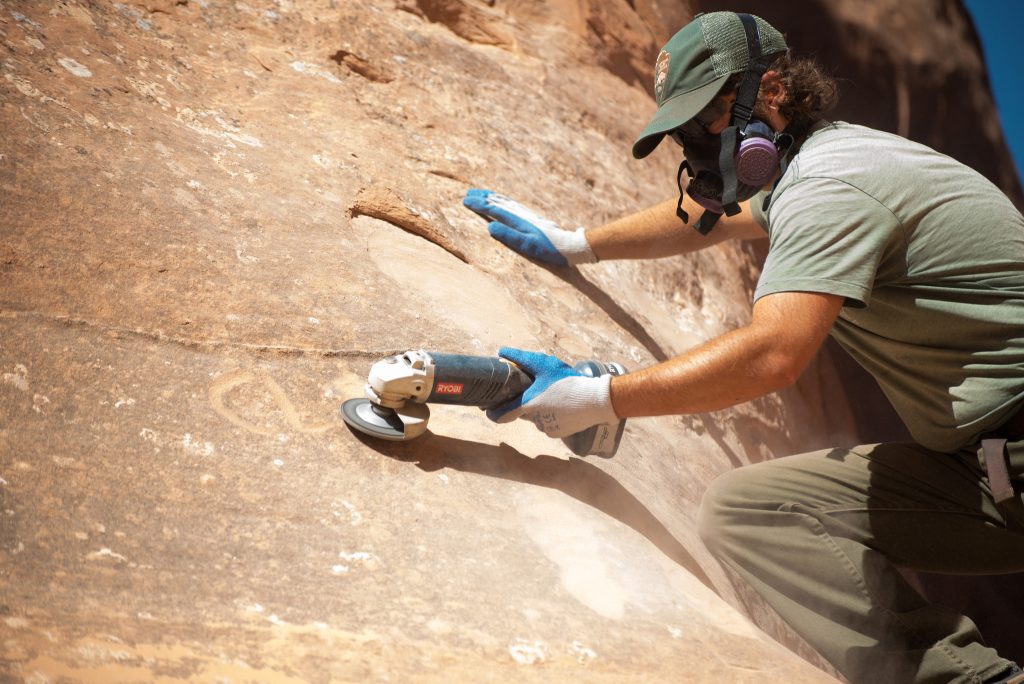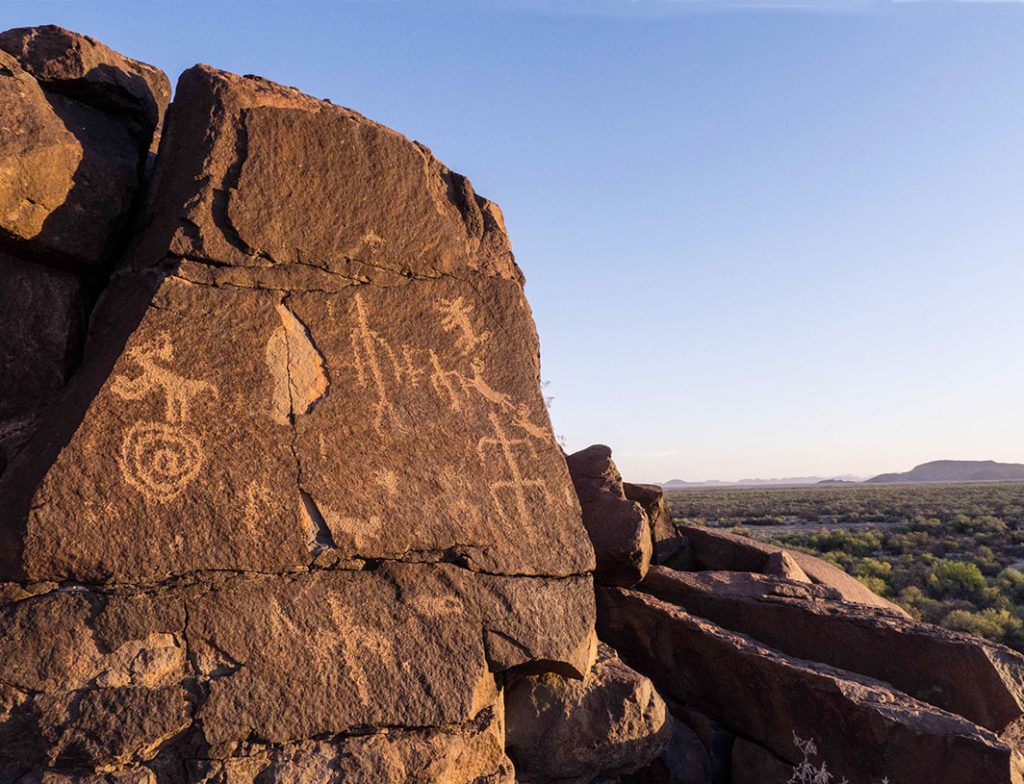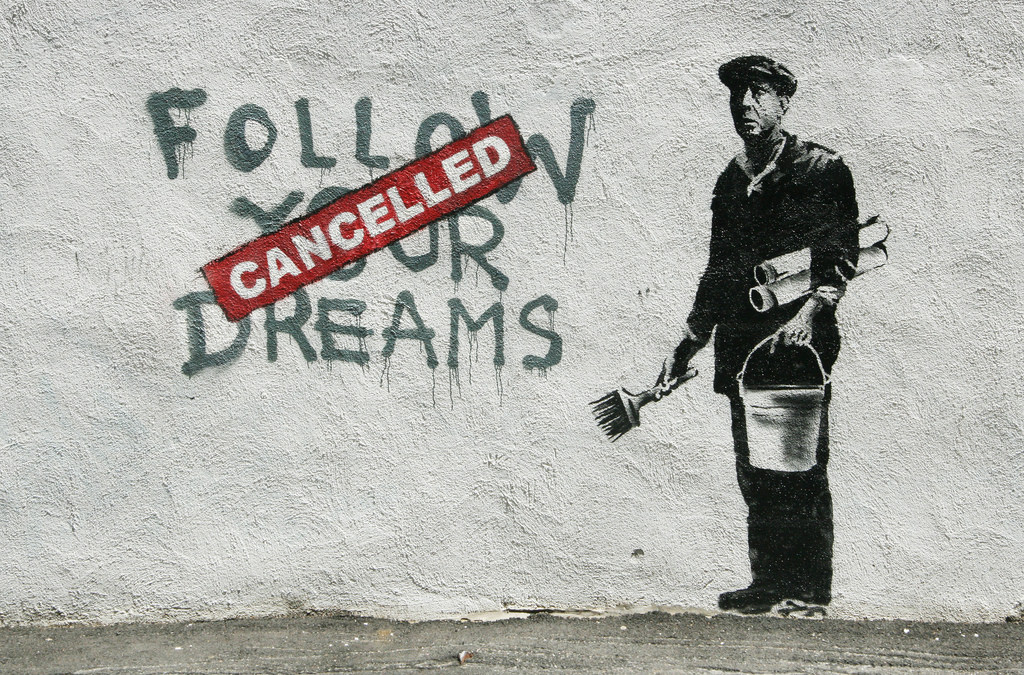Graffiti Bombing in U.S. National Parks

In September and October 2014, someone went on a graffiti spree through seven national parks and monuments in the western U.S., using acrylic paints and markers to create images on rock faces and signing them “Creepytings.” Readers of the blog Modern Hiker and the social network Reddit quickly uncovered the perpetrator, who had bragged about her graffiti on Instagram and Tumblr—tagging some of her posts with #leaveyourmark.
The vandal turned out to be a young woman from Highland, New York, named Casey Nocket, who had spent 26 days touring the West. Her social media profiles sketched the outlines of a woman interested in social causes but who appeared to be living a fairly privileged life. And, at least initially, she showed little remorse for her actions.
After a lengthy National Park Service investigation, Nocket pleaded guilty this past June to seven misdemeanor counts of damaging government property. She will serve two years of probation—during which she is not allowed in any areas overseen by the National Park Service, U.S. Forest Service, Bureau of Land Management, and Army Corps of Engineers—and is required to complete 200 hours of community service and pay an undetermined fine.
Sadly, while actions as brazen and sweeping as Nocket’s are rare, graffiti on public lands has become quite common. In recent years, the media has reported on a few incidents, including actress Vanessa Hudgens carving into Bell Rock near Sedona, Arizona, and Swedish-Portuguese artist Andre Saraiva, known as “Mr. Andre,” defacing Joshua Tree National Park. But hundreds of such incidents never make the news.
Nocket’s case prompted a massive online outcry against her. But there have also been voices on social media—Instagram, Tumblr, Reddit, and Modern Hiker—questioning whether what she did was unethical. These people claim that she is an artist, not a vandal.
The arguments in support of Nocket take two forms. The first is that her work is comparable to rock art seen throughout the American West. For example, one Modern Hiker commenter wrote, “Didn’t cavemen used to paint all over nature?”
But there is a major difference in meaning between Nocket’s work and Indigenous rock art. Rock art was created for specific cultural and religious purposes: to mark territory and to record things such as astronomical explosions, spiritual visions, and interactions with other groups. In contrast, Nocket’s graffiti was apparently all about self-aggrandizement.
Importantly, rock art sites are still visited by tribal groups. They are sacred sites—places with stories, meanings, histories, and observations about previous human activities. So no, Nocket’s drawings were not similar to Native American rock art.
The second, more popular, argument is that Nocket is a street artist. Some in the street art community have even claimed her as their own. Her Creepytings Tumblr account was taken over by a street art crew based in central California. The Instagram account “theofficialcreepytings” (an account that is likely not owned by Nocket) tagged at least one of her photos with #whatsupbanksy—likening her to the popular British street artist Banksy—and now has more than 700 followers.
Some journalists and writers have also drawn the connection between her paintings and street art, or have at least implied that Nocket’s work is a positive, even revolutionary, act. Jason Blevins at The Denver Post called Nocket “a sort of Banksy in the wild.” In an online post for Cosmopolitan magazine that has been extensively revised, comedian and writer Lane Moore initially wrote that Nocket was “inspiring a lot of girls to break some rules.”
When it comes to street art, context is important. Writer Alexander Nazaryan observed in Newsweek: “There is a wholesale argument about the criminality of graffiti that deserves skepticism: The works of Banksy and Swoon are very much art, and that they appear on the side of a building only enhances their message and allure. But if such work appears on a rock formation in Death Valley, that’s simply a crime, whether you are the next Kandinsky or not.”
For Nazaryan, as for many participants in the discussion surrounding the legitimacy of graffiti, the focus of the conversation is on the spatial context of the art—whether or not it’s urban. Yet there may be something more fundamentally important to understanding street art—something that is harder to figure out except for in these rare instances when the artist is actually revealed. And that is the social context of the painter—the artist’s class, gender, and ethnicity.
At its root, street art is resistance. It’s an act of projecting power into places of powerlessness, claiming control where there is none, and giving the voiceless a voice. It’s often a path of opposition for those in oppressed ethnic and economic groups. The oppressors are not simply the government, but anyone who either unabashedly or unknowingly profits from lopsided social, economic, and political relationships. Those who profit from structural inequalities. In essence, those who have privilege. Street art, when used effectively, is a form of activism, of demonstrating that you are human and that you matter.
Street art, or vandalism as activism, regularly questions the current structures of privilege. But Nocket was not using her art this way. She wasn’t wielding her paintbrush to assail her position in society or to question affluence and the structures of class. She wasn’t pushing against domination by an elite group. Instead, judging from a number of factors, including her month-long vacation through the West, she was in a position of power. A person with social or economic privilege who uses vandalism as art is saying something very different from those who have no other outlet and are trying to be heard.
Is Nocket an artist? Sure. Is what she has done art? Sure. Is it the same as the street art she is trying to copy? No. This is not a case of questioning the status quo. Instead, it is a case of enforcing the status quo.
The Creepytings artist placed her work into a position of power over instead of power against. Even more dangerously, she chose the national parks as her canvas. While these parks are national resources aimed at benefiting everyone, and her actions impact everyone who has an interest in maintaining the sanctity of the parks as nature preserves, many of these places are sacred, living landscapes for contemporary tribes. In this context, her paintings took on an even stronger tone of enforcing power over another group—Native Americans—that has already suffered heavily.
Nocket’s work, and the art of all vandals of national parks and other public spaces who come from privilege, is art with a message of entitlement.
Nocket’s paintings produced an entirely different message than what many of her supporters claimed when they linked her with urban street art. Nocket’s work, and the art of all vandals of national parks and other public spaces who come from privilege, is art with a message of entitlement—of mine, not yours, of me, not you. If street art is a form of activism against oppression, inverting those messages makes art that is a form of repression. It signals that control of social spaces—that power—belongs only to a select few.
Hopefully the end result of this whole episode will be lessons learned—for Nocket, and maybe for all of us. As Nocket herself wrote in her high school newspaper in 2010 about a memorial garden at her school funded by families who lost relatives to tragedy, “It is a reminder of how decisions can alter a life, and how many catastrophic effects a simple choice can bear.” Nocket has a chance to learn that besides damaging shared public spaces in nature, her art actually created social damage.
While many view her punishment as too weak, I think the community-service component has the chance to transform her into an ally of public lands and the disenfranchised. In many ways, this is an opportunity for growth that isn’t available to a lot of people. Decisions can alter lives, but even the bad ones can lead to something beautiful if you learn from them.





























